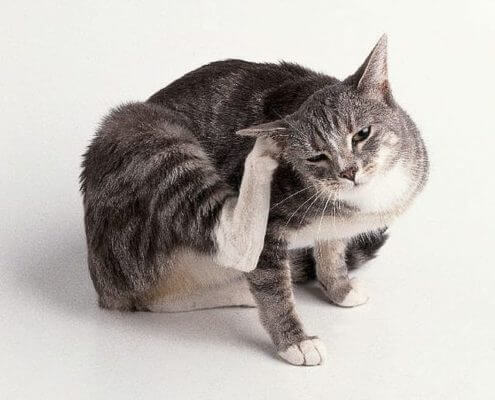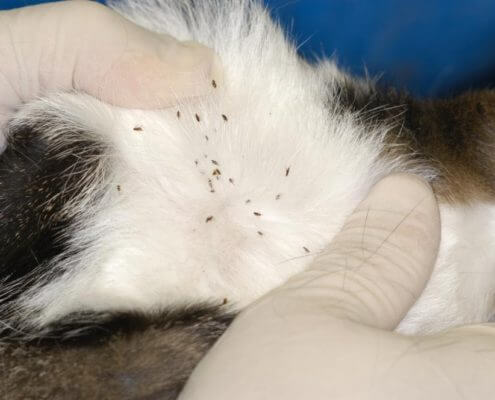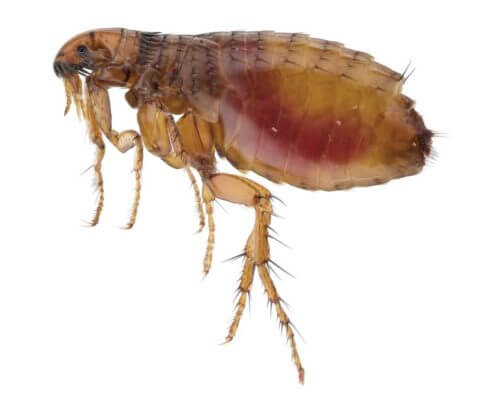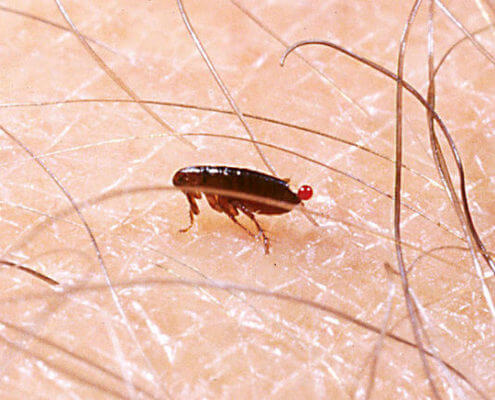Fleas
The most common species of Flea is the Cat Flea, known for readily biting humans. The Bird Flea are next in importance, followed by the rare Dog Fleas, although other species may become temporarily attached to dogs. Finally, there are Human Fleas which are extremely rare.
Appearance
Adult fleas are small (averages 2mm in size) wingless insects, with flattened and red-brown, with backwardly directed spines and legs designed for jumping.
Characteristics
All adult Fleas are parasitic, living on warm-blooded animals. The females lay their eggs after feeding on the infested animal. Female Fleas can live up to two years, during which time they can lay up to 1000 eggs. The eggs drop onto the floor and the animal’s bedding – they can’t lay viable eggs in the absence of the host animal blood meal. After several days the eggs will develop into larvae. When fully grown the larvae spin well camouflaged silken cocoons. When fully developed the adult waits within this until it detects the vibrations caused by a potential host. Only then does it emerge. The complete life cycle takes about a month in the summer.
Habitat
Mainly active in communal rooms where pets sleep and where there is most activity. Fleas are found to be living on domestic animals, in carpets, pet bedding and upholstered furniture.
Diet
Adult Fleas feed on the blood of humans and animals. The larval stages live in the nest of the host and feed on skin, feathers and, most importantly, the blood-rich faeces of the adult flea.
Why control Fleas?
In the UK there is little evidence that Fleas spread disease. However, Flea bites can cause intense irritation around the central bright red spot. Different people react differently to a bite, both regarding the degree of reaction and time taken to react.
Signs of a Flea infestation
Pets constantly scratching may be the first sign, which can be confirmed either by seeing fleas or flea droppings in the coat of your pet. These signs are easily spotted in light coloured animals by brushing back the hair. In dark coated breeds it may be better to comb the animal over a sheet of paper to highlight any flea droppings as they fall. The identity of the black specks may be confirmed by adding a few drops of water if they turn red, your pet has fleas.
You might spot bites on you or family members, usually around ankles and legs. In humans, flea bites can produce an irritating and allergic reaction. The typical symptom of a flea bite is a small red spot about 5mm in diameter.
If you have an active infestation, you may see Fleas jumping in your carpet and furniture.
How do I prevent a Fleas?
It’s difficult to prevent your pets from getting Fleas. However, there are some things you can do to reduce your chances of getting them:
- Pet maintenance – Applying veterinary approved Flea products to your pet on a regular basis.
- Vacuuming – Frequently vacuum the areas your pet is around, especially carpeted areas in and any furniture that is frequented by your pet.
- Washing – Regularly wash your pet’s bedding, blanket and other washable items in the hottest water possible.
- Gardening – Try and keep your garden neat and tidy by mowing your lawn and raking up any leaves, grass or bush clippings.
How to get rid of Fleas
For a Flea infestation, we strongly recommend you contact us ASAP. We are trained professional will have the technical knowledge and access to a range of professional use insecticides which are not available to the public.
Before an insecticide treatment, clear as much floor space as possible to ensure that treatment is as thorough as possible. Vacuuming all areas helps to remove any debris, eggs, larvae and adult fleas. The vibration of the vacuum cleaner also stimulates adults to hatch from their cocoon stage. Remember to remove the waste collection compartment/bag, from the vacuum cleaner, and dispose of it in an outside bin as you may have collected eggs, larvae and adult fleas while vacuuming.
The standard treatment for infested premises is the application of a residual insecticide, either as a liquid spray or powder. The insecticide is applied to all floor surfaces. Ensure you do not vacuum or wash for at least two weeks (or longer if possible), or you’ll be in danger of eliminating the residual insecticide which will lead to a failed treatment.
Having problems with Fleas?
CLICK HERE TO CONTACT US NOW
All photos copyright their respected owners, photos provided for educational & identification purposed only.






